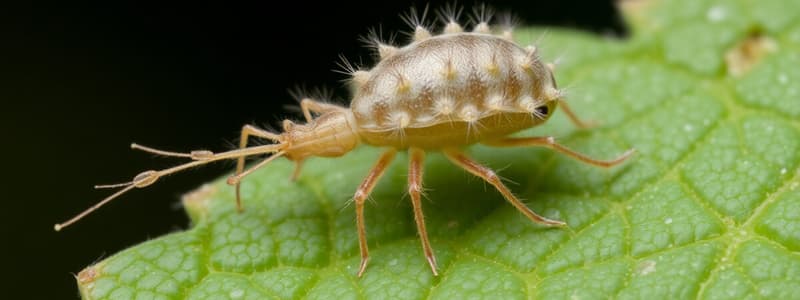Podcast
Questions and Answers
What conditions favor the multiplication of leaf gall mites?
What conditions favor the multiplication of leaf gall mites?
- Cold winter conditions
- Presence of other insects
- Wet and humid environments
- Hot weather conditions (correct)
What is the primary effect of leaf gall mite infestation on plants?
What is the primary effect of leaf gall mite infestation on plants?
- Improved resistance to diseases
- Reduction in plant biomass (correct)
- Increased leaf size and thickness
- Enhanced photosynthetic activity
Where are galls caused by leaf gall mites typically found?
Where are galls caused by leaf gall mites typically found?
- On the stems of the plant
- On the leaf surface and tender terminal shoots (correct)
- On the roots of the plant
- In the soil surrounding the plant
When should acaricides be applied to manage leaf gall mites?
When should acaricides be applied to manage leaf gall mites?
What is a characteristic feature of the galls formed by leaf gall mites?
What is a characteristic feature of the galls formed by leaf gall mites?
Flashcards are hidden until you start studying
Study Notes
Leaf Gall Mite - Aceria pongamiae
- The leaf gall mite, Aceria pongamiae, is a pest of the pungam tree.
- Mites multiply on pungam during the summer months when new flush appears.
- Adult mites prefer young leaves for egg laying.
- Newly hatched nymphs cause damage to the leaf surface, forming pouch galls and disfiguring the leaves.
- Hot weather conditions favor mite multiplication.
- Galls are solitary, elongate, pouch-like, and have truncated apices on the upper leaf surface.
- Galls are indeterminate, green, smooth, and hollow with a small escape hole (ostiole).
- Galls are often twisted and curved.
- Galls can be found on the leaf lamina, secondary veins, midrib, and tender terminal shoots.
- Mite infestation significantly impacts photosynthetic activity and reduces plant biomass.
- Management strategies include removing affected leaves.
- Applying acaricides like Fenazaquin or propargite at 1 ml/liter of water during new flush formation in summer can also help control the infestation.
Studying That Suits You
Use AI to generate personalized quizzes and flashcards to suit your learning preferences.




